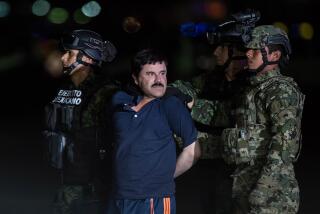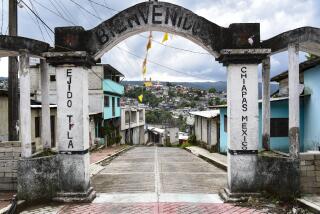Rebel War Leaks Beyond Colombia’s Borders
- Share via
TIBU, Colombia — Colombia’s leftist guerrillas have begun infiltrating neighboring countries since the collapse of peace talks in February, threatening to further destabilize an already unsteady region.
Authorities in Brazil, Peru and Ecuador have reported encounters in recent weeks with the Revolutionary Armed Forces of Colombia, which goes by the Spanish initials FARC.
But the most serious incident so far happened a few miles north of this outpost on the border between Venezuela and Colombia. In late March, at least 300 FARC rebels clashed with a Colombian military squad, leaving 41 dead--about half of them on each side.
Colombian military officials and local people said the FARC launched part of the attack from inside Venezuela. Venezuelan President Hugo Chavez, who recently overcame an attempt to oust him, denied the accusation, but people on the Venezuelan side of the border say the Colombian rebels have long had a presence there.
The incursions come at a delicate time for the region. In Peru, President Alejandro Toledo faces a surge in terrorism and planting of drug crops. Brazil is in the midst of a turbulent election year.
Venezuela also is facing political upheaval. Last month, top military officers forced Chavez to resign before he turned the tables and returned to power just a few days later.
Incidents along the border began shortly after Colombian President Andres Pastrana declared an end on Feb. 20 to a special peace zone in southern Colombia that had served as a de facto headquarters and training ground for the FARC, the largest guerrilla army in Latin America.
FARC leaders ordered small squads of rebels streaming out of the Switzerland-sized region to avoid capture, according to Colombian military officials, sending the guerrillas out across the swampy plains that make up this country’s interior.
The maneuver was apparently successful. Despite intense military operations in the former zone, no FARC leaders have been captured and few of the estimated 8,000 rebels there have been killed.
Many of the guerrillas fled to neighboring countries, Colombian military officials believe. It is not clear whether they are seeking to establish permanent bases or are temporarily regrouping.
The first signs of trouble came in early March, when Brazilian police fought a gun battle with FARC members attempting to recruit indigenous groups, according to a Brazilian diplomatic source.
A week later, Ecuadorean military officials found an abandoned FARC camp in Sucumbios province on the border with Colombia.
Peruvian authorities have said that since the peace talks in Colombia ended, more than half a dozen FARC members have entered Peru near its border with Colombia to resupply themselves. Another FARC member was reportedly arrested on his way to Lima, the Peruvian capital.
But the most violent clash took place here in Catatumbo, a lawless region of thick jungle, soaring mountains and coca fields on the border between Colombia and Venezuela.
Catatumbo sits in a broad valley between two mountain ranges--one in Colombia and one in Venezuela--which has become prime territory for growing coca. The region registered one of the biggest gains in Colombia last year in the growth of coca, the source of cocaine.
The area has become a battleground in recent years between the FARC and Colombia’s right-wing paramilitaries, both of which finance their war with drug profits.
On Friday, authorities reported that as many as 60 people, many of them civilians, were killed in clashes between the FARC and paramilitary groups in an isolated corner of northwestern Colombia.
David Mosquera, the acting governor of Choco state, said the casualties occurred Thursday and early Friday as the two sides battled for control of the region around the village of Bojaya. He said some of the civilians were killed when FARC rebels fired homemade mortars into a church Thursday.
In Catatumbo, in the northeast, more than 30 people have disappeared or been killed since the beginning of the year, according to one local estimate.
“We feel squeezed by all sides,” said Taiz del Pilar Ortega, the town’s mayor. “We are worried that things are going to get even worse.”
Colombian military officials believe that a large group of between 500 to 800 rebels who left the former peace zone arrived in this area in early March to join an existing unit, the FARC’s 33rd Front.
When the reinforcements arrived, military officials say, the 33rd Front began an offensive against the paramilitaries, who had taken control of most of the region’s coca trade.
On March 15, they gathered local residents, mostly small coca farmers, and declared that no vehicle could enter or leave the area. They set fire to eight cars and buses in the following days, and locals began fleeing.
They also burned residents’ identity cards in an apparent effort to prevent them from voting in presidential elections this month. The leading candidate, Alvaro Uribe, says he will increase military spending and take a harder line toward the FARC.
The action prompted the local Colombian military battalion to begin a search for the guerrillas. On March 20, they found them just outside El Milagro, half a mile from the Venezuelan border.
For four hours, according to the local military commander, his group battled about 300 rebels, some of them teenagers and women. The rebels retreated to the Venezuelan side of the border and began launching homemade mortars built from gas cylinders. The mortars were responsible for most of the 21 army deaths, the local commander said.
The commander, who spoke on condition he not be identified, called in an AC-47 gunship for airstrikes, but the Colombian air force pilot refused to shoot because the rebels were in Venezuela.
“I was screaming at him, ‘Brother, hey, shoot them, shoot them,’ ” said the commander, his voice rising. “If he had just done that, the battle would have been different.”
Local peasants back up at least part of the military commander’s version. They say they noticed an increase in FARC rebels in early March.
“They use the frontier strip because it makes it much easier for them to move,” said Jairo Gomez, head of a local farmers union.
In La Fria, a tiny Venezuelan town just over the border, ranchers said that guerrillas had been crossing into Venezuela for decades. Among eight men and women talking inside a regional ranchers association hall, four had had family members kidnapped or killed by Colombian guerrillas in the past 10 years.
But the number of guerrillas jumped dramatically after the end of the peace process, they said.
“There is no government in this area,” said Andres Querales, a veterinarian. “There is tremendous impunity. They’ll kill one of our employees, take our money, and nothing happens.”
The local Venezuelan military commander said that he cannot be sure whether the guerrillas launched the March attack from Venezuela.
Gen. Wilfrido Cruz, who is responsible for the Venezuelan side of the Catatumbo region, said that he had flown over the area in search of guerrillas the day after they had fought the Colombian military, but had found no sign of them or any guerrilla base. Since the border is not clearly marked, the guerrillas could have mistakenly entered Venezuela, he said.
But he also said he could not rule out Colombia’s accusations.
“It could be possible,” Cruz said. “It’s an open frontier. But what is important is that any armed actor found on our side of the border, guerrilla, paramilitary, whatever, will be pursued by our forces.”
*
Miller is The Times’ Bogota Bureau chief. He is currently on assignment in the Middle East.
More to Read
Sign up for Essential California
The most important California stories and recommendations in your inbox every morning.
You may occasionally receive promotional content from the Los Angeles Times.










